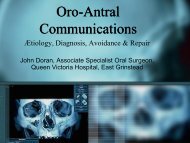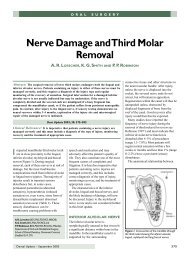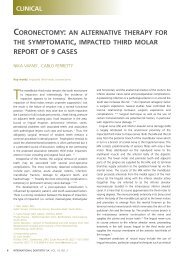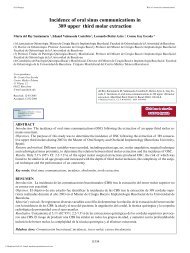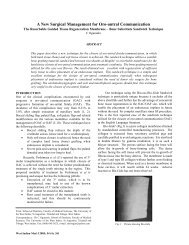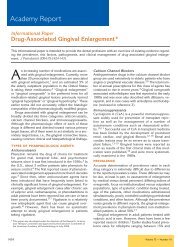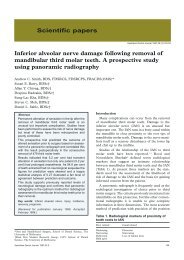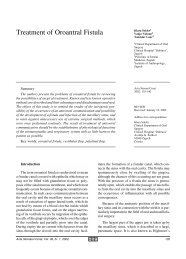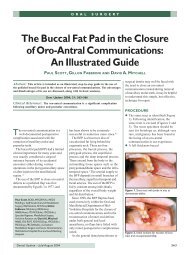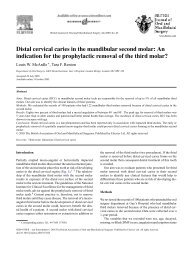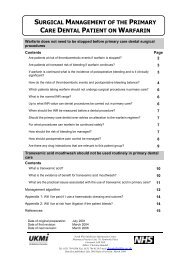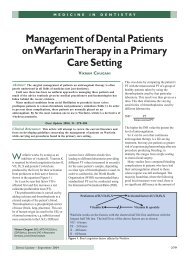Drug-Induced Gingival Hyperplasia - Surgical-Dentistry.Info
Drug-Induced Gingival Hyperplasia - Surgical-Dentistry.Info
Drug-Induced Gingival Hyperplasia - Surgical-Dentistry.Info
You also want an ePaper? Increase the reach of your titles
YUMPU automatically turns print PDFs into web optimized ePapers that Google loves.
eMedicine - <strong>Drug</strong>-<strong>Induced</strong> <strong>Gingival</strong> <strong>Hyperplasia</strong> : Article by Piamkamon Vacharotayangul, DDS, PhD1/27/08 10:44 PMHOME SPECIALTIES REFERENCE CENTERSSearch: eMedicine Clinical Reference, <strong>Drug</strong> Reference, MEDLINE, and moreSearchYou are in: eMedicine Specialties > Dermatology > Diseases Of The Oral Mucosa<strong>Drug</strong>-<strong>Induced</strong> <strong>Gingival</strong> <strong>Hyperplasia</strong>Email to a ColleagueLast Updated: December 15, 2006Synonyms and related keywords: gingival overgrowth, gingival enlargement, gum overgrowth, gumenlargement, gum hyperplasia, cyclosporine, phenytoin, calcium antagonist-induced gingivalhyperplasiaAUTHOR INFORMATION Section 1 of 11Author <strong>Info</strong>rmation Introduction Clinical Differentials Workup Treatment Medication Follow-up Miscellaneous Pictures BibliographyAuthor: Piamkamon Vacharotayangul, DDS, PhD, Lecturer, Division of Oral Medicine, Department of Oral Surgery andOral Medicine, Faculty of Medicine, Sri Nakharinwirot University School of <strong>Dentistry</strong>, Bangkok, ThailandCoauthor(s): Francina Lozada-Nur, DDS, MS, MPH, Department of Orofacial Sciences, Professor, Program Director inAdvanced Program in Oral Medicine, University of California at San Francisco; Associate Clinical Professor, Department ofDermatology, Stanford UniversityPiamkamon Vacharotayangul, DDS, PhD, is a member of the following medical societies: American Academy of OralMedicineEditor(s): Franklin Flowers, MD, Chief, Division of Dermatology, Professor, Department of Medicine and Otolaryngology,University of Florida College of Medicine; David F Butler, MD, Professor, Texas A&M University College of Medicine;Director, Division of Dermatology, Scott and White Clinic; Drore Eisen, MD, DDS, Consulting Staff, Department ofDermatology, Dermatology Research Associates of Cincinnati; Glen H Crawford, MD, Assistant Clinical Professor,Department of Dermatology, University of Pennsylvania School of Medicine; Chief, Division of Dermatology, ThePennsylvania Hospital; and William D James, MD, Paul R Gross Professor of Dermatology, University of PennsylvaniaSchool of Medicine; Vice-Chair, Program Director, Department of Dermatology, University of Pennsylvania Health SystemDisclosureQuick FindAuthor <strong>Info</strong>rmationIntroductionClinicalDifferentialsWorkupTreatmentMedicationFollow-upMiscellaneousPicturesBibliographyClick for relatedimages.Related ArticlesPatient EducationTeeth and MouthCenterGingivitis OverviewGingivitis CausesGingivitisSymptomsGingivitisTreatmentWhen to Visit theDentist -IntroductionINTRODUCTION Section 2 of 11Author <strong>Info</strong>rmation Introduction Clinical Differentials Workup Treatment Medication Follow-up Miscellaneous Pictures BibliographyBackground: <strong>Gingival</strong> overgrowth (GO), also known as gingival hyperplasia secondary to drugs, was first reported in thedental literature in the early 1960s in institutionalized epileptic children who were receiving therapy with phenytoin (Dilantin)for the treatment of seizures. Recently, cyclosporine (a potent immunosuppressant widely used since the early 1980s inorgan transplant recipients and for psoriasis) and numerous calcium channel blocker agents (especially nifedipine) havebeen associated with GO. Nifedipine appears to have an additive effect when used together with cyclosporine in transplantrecipients with hypertension.http://www.emedicine.com/DERM/topic645.htmPage 1 of 8
eMedicine - <strong>Drug</strong>-<strong>Induced</strong> <strong>Gingival</strong> <strong>Hyperplasia</strong> : Article by Piamkamon Vacharotayangul, DDS, PhD1/27/08 10:44 PMBecause not all patients on phenytoin, cyclosporine, or calcium antagonists develop GO, identifying patients at risk isimportant in order to take the necessary measures to minimize the onset and severity of this condition.Currently, the etiology of drug-induced GO is not entirely understood but is clearly multifactorial. One of the main reasonsfor this is that clinical and epidemiologic studies on the role of drugs in GO are retrospective.Some of the risk factors known to contribute to GO include the presence of gingival inflammation (gingivitis due to poor oralhygiene), presence of dental plaque that may provide a reservoir for the accumulation of phenytoin or cyclosporine, thedepth of the periodontal pocket on probing, and the dose and duration of cyclosporine therapy.Other intrinsic risk factors include the susceptibility of some subpopulations of fibroblasts and keratinocytes to phenytoin,cyclosporine, or nifedipine, and the number of Langerhans cells present in oral epithelium. The latter appears to be relatedto the presence of inflammation and dental plaque.Because most of the studies reported so far observed patients who had GO at the time of the study, it is quite difficult todetermine the true effect of the medication independent of cofactors (ie, severity of the underlying disease, oral healthstatus prior to the onset of GO [premature tooth loss, periodontal disease, routine oral hygiene], socioeconomic status,education); however, it is clear that the status of oral/dental health prior to onset of GO combined with medication areinvolved in the onset of this condition.Pathophysiology: Several studies have shown that the interaction of phenytoin, cyclosporine, and nifedipine with epithelialkeratinocytes, fibroblasts, and collagen can lead to an overgrowth of gingival tissue in susceptible individuals. Phenytoin hasbeen shown to induce GO by its interaction with a subpopulation of sensitive fibroblasts. Cyclosporine has been suggestedto affect the metabolic function of fibroblast (eg, collagen synthesis, breakdown), whereas nifedipine, which potentiates theeffect of cyclosporine, reduces protein synthesis of fibroblasts. A review of existing literature shows that a cofactor clearly isneeded to induce GO.Frequency:In the US: GO is a rare condition, and no population-based or epidemiologic studies exist in the United States.Incidence rates are reported from case-series studies. The prevalence of phenytoin-induced GO is estimated at 15-50% in patients taking the medication. The prevalence for cyclosporine transplant recipient patients is 27%; however,these numbers should be interpreted with caution. The incidence of gingival hyperplasia has been reported as 10-20% in patients treated with calcium antagonists in the general population. Clinicians should look at the populationrepresented within each particular study (ie, young persons with epilepsy, recipients of transplants).Internationally: No incidence or prevalence epidemiologic data is available on GO worldwide. In India, 57% ofepileptic children aged 8-13 years who were undergoing phenytoin monotherapy developed GO within 6 months oftreatment.Mortality/Morbidity: No mortality is associated with gingival enlargement. Morbidity can be severe in some cases becauseof gross overgrowth of gingival tissue, which can lead to gingival bleeding, pain, teeth displacement, and periodontaldisease.Race: No racial predilection exists for the onset of drug-induced GO.Sex: No sexual predilection exists for drug-induced GO, although in one study, males were 3 times more likely thanfemales to develop GO with calcium antagonists.Age: No age predilection exists for the onset of drug-induced GO; however, phenytoin-induced GO appears to be morefrequent in young patients with epilepsy. Most likely, this may be related to the age of the population, the nature of thedisease, and poor oral hygiene.CLINICAL Section 3 of 11Author <strong>Info</strong>rmation Introduction Clinical Differentials Workup Treatment Medication Follow-up Miscellaneous Pictures BibliographyHistory: The onset of drug-induced GO in susceptible individuals is insidious. GO is asymptomatic, except in the presenceof poor oral hygiene and dental plaque because patients may develop bleeding with tender and swollen gums. Patients withmalpositioned teeth, periodontal disease, and poor oral hygiene are at risk of developing GO. Severity varies depending onthe oral/dental health prior to the beginning of therapy; however, not all patients with poor oral hygiene develop druginducedGO.Phenytoin-induced GOThis is more likely to occur in patients with gingivitis and dental plaque.Increased dental plaque has been suggested to induce local inflammation and to serve as a reservoir forphenytoin.Cyclosporine-induced GOIn susceptible patients (ie, presence of dental plaque, swollen gums, high dose of cyclosporine), GO mayhttp://www.emedicine.com/DERM/topic645.htmPage 2 of 8
eMedicine - <strong>Drug</strong>-<strong>Induced</strong> <strong>Gingival</strong> <strong>Hyperplasia</strong> : Article by Piamkamon Vacharotayangul, DDS, PhD1/27/08 10:44 PMPhysical:develop by the third month of therapy.Patients with poor oral hygiene and displaced teeth tend to develop bleeding gums upon probing.Aggressive plaque control and routine oral hygiene help in maintaining gums but may not prevent the onset ofGO in susceptible individuals.Cyclosporine-induced GO is reversible once therapy is discontinued or when the dose is reduced.Cyclosporine- and nifedipine-induced GO: Nifedipine potentiates the adverse effect (ie, GO) of cyclosporine.Calcium antagonist–induced GOOral hygiene plays a decisive role in the development of gingival enlargement.Substantial evidence in the dental literature indicates that gingival enlargement can be controlled successfully,even under the continuous administration of calcium antagonists, by meticulous professional and individualoral hygiene.<strong>Gingival</strong> enlargement occurs primarily on the labial gingival mucosa and in between the teeth (interdental papillaearea).GO is more pronounced on the labial aspect of the maxillary gingiva and in the interdental papillae.Causes: Potential risk factors for drug-induced GO include the following:Poor oral hygienePeriodontal diseasePeriodontal pocket depth<strong>Gingival</strong> inflammationDegree of dental plaqueDuration and dose of cyclosporineDIFFERENTIALS Section 4 of 11Author <strong>Info</strong>rmation Introduction Clinical Differentials Workup Treatment Medication Follow-up Miscellaneous Pictures BibliographyOther Problems to be Considered:Leukemia (bleeding gums)Pyogenic granulomaPregnancy tumorWartsWORKUP Section 5 of 11Author <strong>Info</strong>rmation Introduction Clinical Differentials Workup Treatment Medication Follow-up Miscellaneous Pictures BibliographyLab Studies:CBC count is indicated in patients with severe gum bleeding to rule out anemia and leukemia.Imaging Studies:Periapical (full mouth series) or Panorex (panoramic view) radiographs are indicated prior to treatment to evaluate the status of the periodontaltissue or any compromised teeth.Other Tests:Procedures:Culture is recommended to rule out oral candidiasis.Tissue biopsy may be indicated if GO has an unusual clinical presentation or if the patient is not on a medication known to induce GO.Periodontal examination is necessary to evaluate for the presence of periodontal disease.http://www.emedicine.com/DERM/topic645.htmPage 3 of 8
eMedicine - <strong>Drug</strong>-<strong>Induced</strong> <strong>Gingival</strong> <strong>Hyperplasia</strong> : Article by Piamkamon Vacharotayangul, DDS, PhD1/27/08 10:44 PMDental hygiene is required to remove dental plaque.Root planing may be indicated.Dental extraction of periodontically compromised teeth is indicated if those teeth may interfere with subsequent medical treatment. It also maybe considered if the patient cannot perform prophylactic dental care (eg, young epileptic patient).Histologic Findings: Histologic changes are similar in GO that is caused by either phenytoin or cyclosporine. The term gingival hyperplasia isinappropriate because enlargement does not result from an increase in the number of cells but rather an increase in extracellular tissue volume.A highly vascular connective tissue occurs histologically with focal accumulation of inflammatory cells, primarily plasma cells. The overlying epitheliumis of variable thickness, irregular, and multilayered. Acanthosis and parakeratosis with pseudoepitheliomatous proliferation have been reported.Immunohistologic studies have demonstrated an increase in the number of Langerhans cells within the epithelium and adjacent to inflamed sites.TREATMENT Section 6 of 11Author <strong>Info</strong>rmation Introduction Clinical Differentials Workup Treatment Medication Follow-up Miscellaneous Pictures BibliographyMedical Care: For dental care, refer patients to a general dentist or oral medicine specialist prior to any organ transplant and before startingtreatment with phenytoin, cyclosporine, or any calcium channel blocker known to induce GO.<strong>Surgical</strong> Care: Gingivectomy with carbon dioxide or YAG laser is recommended for patients who have moderate-to-severe gingival enlargement thatdoes not resolve when the dose is reduced, proper oral hygiene is maintained, or after a short course of antibiotics.Consultations:For evaluation and treatment planning, refer patients to a dental practitioner and an oral medicine specialist familiar with the oral care ofmedically complex patients.An oral medicine specialist and a periodontist should monitor patients with GO for as long as they receive therapy with cyclosporine, phenytoin,or calcium channel blockers to evaluate and treat oral complications from medical therapy.Diet: No diet restrictions are recommended for patients with GO other than minimizing the consumption of sweets, starch, soft drinks, and simplecarbohydrates.Activity: No activity restrictions are reported.MEDICATION Section 7 of 11Author <strong>Info</strong>rmation Introduction Clinical Differentials Workup Treatment Medication Follow-up Miscellaneous Pictures Bibliography<strong>Drug</strong> Category: Antibiotics -- Empiric antimicrobial therapy must be comprehensive and should cover all likely pathogens in the context ofthe clinical setting.http://www.emedicine.com/DERM/topic645.htmPage 4 of 8
eMedicine - <strong>Drug</strong>-<strong>Induced</strong> <strong>Gingival</strong> <strong>Hyperplasia</strong> : Article by Piamkamon Vacharotayangul, DDS, PhD1/27/08 10:44 PM<strong>Drug</strong> NameAdult DosePediatric DoseContraindicationsInteractionsPregnancyPrecautionsAzithromycin (Zithromax) -- Used to treat mild-to-moderate oralmicrobial infections. Macrolide antibiotic that acts bysuppressing protein synthesis of gram-positive and gramnegativeaerobes. Take 1-2 h after meals.Day 1: 500 mg PODays 2-5: 250 mg PO qd>6 monthsDay 1: 10 mg/kg PO once; not to exceed 500 mg/dDays 2-5: 5 mg/kg PO qd; not to exceed 250 mg/dDocumented hypersensitivity; hepatic impairment; do notadminister with pimozideMay increase toxicity of theophylline, warfarin, and digoxin;effects are reduced with coadministration of aluminum and/ormagnesium antacids; nephrotoxicity and neurotoxicity mayoccur when coadministered with cyclosporineB - Usually safe but benefits must outweigh the risks.Site reactions can occur with IV route; bacterial or fungalovergrowth may result with prolonged antibiotic use; mayincrease hepatic enzymes and cholestatic jaundice; caution inpatients with impaired hepatic function, prolonged QT intervals,or pneumonia; caution in patients who are hospitalized,geriatric, or debilitated<strong>Drug</strong> Category: Mouthwash antiseptics -- Antiseptic agent for oral bacterial and fungal infections.<strong>Drug</strong> NameAdult DosePediatric DoseContraindicationsInteractionsPregnancyPrecautionsChlorhexidine gluconate (Peridex) -- Effective, safe, and reliablemouthwash antiseptic. Polybiguanide with bactericidal activity;usually is supplied as a gluconate salt. At physiologic pH, thesalt dissociates to a cation that binds to bacterial cell walls.15 mL rinse and expectorate/spit bid after thoroughly brushingteeth to prevent staining5-10 mL rinse and expectorate/spit bid after thoroughlybrushing teeth to prevent stainingDocumented hypersensitivity; avoid in the presence of any oralulcers or if patient presents with mucositis secondary toradiation or chemotherapyNone reportedC - Safety for use during pregnancy has not been established.Irritation if open ulcers are seen in the mouth; dental deposits,staining of teeth, taste changes, and parotitis have beenreported<strong>Drug</strong> NameAdult DosePediatric DoseContraindicationsInteractionsPregnancyPrecautionsLysozyme, lactoferrin, glucose oxidase, lactoperoxidase(Biotene) -- Alcohol-free mouthwash antiseptic.Rinse mouth bid/tid pcAdminister as in adultsDocumented hypersensitivityNone reportedC - Safety for use during pregnancy has not been established.None reportedFOLLOW-UP Section 8 of 11Author <strong>Info</strong>rmation Introduction Clinical Differentials Workup Treatment Medication Follow-up Miscellaneous Pictures BibliographyFurther Outpatient Care:http://www.emedicine.com/DERM/topic645.htmPage 5 of 8
eMedicine - <strong>Drug</strong>-<strong>Induced</strong> <strong>Gingival</strong> <strong>Hyperplasia</strong> : Article by Piamkamon Vacharotayangul, DDS, PhD1/27/08 10:44 PMTo monitor for GO-associated oral complications (eg, bleeding gums, poor oral hygiene, gingivitis, oral candidiasis), oral medicine specialistsshould provide follow-up care twice a year for patients taking drugs known to induce GO.Dental hygiene is recommended every 3 months to control dental plaque.Patients should practice thorough oral hygiene twice a day (ie, before breakfast, before going to bed) and rinse mouth with plain water aftereach meal.In/Out Patient Meds:Chlorhexidine 12% once before going to bed or Biotene mouthwash after meals is recommended for those patients known to be at risk forgingivitis.Deterrence/Prevention:Ensure healthy periodontal tissue prior to any organ transplantation or the use of phenytoin or calcium channel blocker.Consider alternative drugs (ie, mycophenolate [CellCept], or tacrolimus [Prograf] in organ transplant recipients, verapamil in place of calciumchannel blockers) for patients at high risk. One study showed that in a case of pediatric renal transplantation, GO was improved after switchingfrom cyclosporine A to tacrolimus.Use lower doses of cyclosporine.Educate patients about the importance of good oral hygiene and routine dental care, not only to minimize GO but also to reduce risk ofsystemic complications, including organ rejection.Complications:Prognosis:Severe GO in patients with poor oral health can lead to early tooth loss.Chlorhexidine 12% mouthwash might cause teeth staining; however, brushing teeth prior to rinsing out with chlorhexidine can prevent it. Thestain can be removed by routine oral prophylaxis.The prognosis is better if patients maintain regular oral hygiene and plaque control.Patient Education:<strong>Info</strong>rm patients of the risk of developing gingival enlargement secondary to therapy and the role of oral health in minimizing complications fromtherapy.Advise patients to see a pedodontist, a periodontist, and an oral medicine dentist for a baseline evaluation; full mouth x-ray films; toothextractions, if needed; and dental hygiene before transplant or the use of any drug known to induce GO.For excellent patient education resources, visit eMedicine's Teeth and Mouth Center. Also, see eMedicine's patient education articles Gingivitisand When to Visit the Dentist.MISCELLANEOUS Section 9 of 11Author <strong>Info</strong>rmation Introduction Clinical Differentials Workup Treatment Medication Follow-up Miscellaneous Pictures BibliographyMedical/Legal Pitfalls:Failure to perform appropriate diagnostic procedures (ie, periodontal evaluation, full mouth x-ray film, routine histology)Failure to appropriately identify and monitor patients at risk for the development of gingival overgrowth secondary to systemic therapy known toinduce gingival overgrowth (ie, regular oral hygiene, frequent visits to dental professional)Special Concerns:Emphasize the importance of good oral hygiene and routine dental care.In a patient who is pregnant, rule out pregnancy tumor/pyogenic granuloma.Refer all patients, regardless of sex and age, to their dentists prior to therapy with medications known to induce GO.PICTURES Section 10 of 11Author <strong>Info</strong>rmation Introduction Clinical Differentials Workup Treatment Medication Follow-up Miscellaneous Pictures BibliographyCaption: Picture 1. Swelling of the gingival mucosa around the right lower canineand multiple areas of erythema, erosions, and bleeding throughout the uppergingival mucosa.http://www.emedicine.com/DERM/topic645.htmPage 6 of 8
eMedicine - <strong>Drug</strong>-<strong>Induced</strong> <strong>Gingival</strong> <strong>Hyperplasia</strong> : Article by Piamkamon Vacharotayangul, DDS, PhD1/27/08 10:44 PMView Full Size ImagePicture Type: PhotoCaption: Picture 2. Enlarged upper and lower gingival mucosa in a partiallyedentulous patient. Notice how the overgrown tissue tends to engulf the teeth. Poororal hygiene and poor dentition are the most likely contributing factors in this patientreceiving immunosuppressive therapy.View Full Size ImagePicture Type: PhotoCaption: Picture 3. A palatal view of same patient as in Image 2. Notice theseverity of the gingival enlargement. If left untreated, patients develop severeperiodontal disease and lose teeth.View Full Size ImagePicture Type: PhotoBIBLIOGRAPHY Section 11 of 11Author <strong>Info</strong>rmation Introduction Clinical Differentials Workup Treatment Medication Follow-up Miscellaneous Pictures BibliographyBrown RS, Di Stanislao PT, Beaver WT, Bottomley WK: The administration of folic acid to institutionalized epileptic adults with phenytoininducedgingival hyperplasia. A double-blind, randomized, placebo-controlled, parallel study. Oral Surg Oral Med Oral Pathol 1991 May; 71(5):565-8[Medline].Camargo PM, Melnick PR, Pirih FQ, et al: Treatment of drug-induced gingival enlargement: aesthetic and functional considerations.Periodontol 2000 2001; 27: 131-8[Medline].Cebeci I, Kantarci A, Firatli E, et al: The effect of verapamil on the prevalence and severity of cyclosporine-induced gingival overgrowth in renalallograft recipients. J Periodontol 1996 Nov; 67(11): 1201-5[Medline].Daly CG: Resolution of cyclosporin A (CsA)-induced gingival enlargement following reduction in CsA dosage. J Clin Periodontol 1992 Feb;19(2): 143-5[Medline].Fu E, Nieh S, Chang HL, Wang SL: Dose-dependent gingival overgrowth induced by cyclosporin in rats. J Periodontol 1995 Jul; 66(7): 594-8[Medline].Hong HH, Uzel MI, Duan C, et al: Regulation of lysyl oxidase, collagen, and connective tissue growth factor by TGF-beta1 and detection inhuman gingiva. Lab Invest 1999 Dec; 79(12): 1655-67[Medline].Hyland PL, Traynor PS, Myrillas TT, et al: The effects of cyclosporin on the collagenolytic activity of gingival fibroblasts. J Periodontol 2003Apr; 74(4): 437-45[Medline].Kinane DF, Drummond JR, Chisholm DM: Langerhans cells in human chronic gingivitis and phenytoin-induced gingival hyperplasia. Arch OralBiol 1990; 35(7): 561-4[Medline].King GN, Fullinfaw R, Higgins TJ, et al: <strong>Gingival</strong> hyperplasia in renal allograft recipients receiving cyclosporin-A and calcium antagonists. JClin Periodontol 1993 Apr; 20(4): 286-93[Medline].Kwun WH, Suh BY, Kwun KB: Effect of azithromycin in the treartment of cyclosporine-induced gingival hyperplasia in renal transplantrecipients. Transplant Proc 2003 Feb; 35(1): 311-2[Medline].Modeer T, Anduren I, Lerner UH: Enhanced prostaglandin biosynthesis in human gingival fibroblasts isolated from patients treated withphenytoin. J Oral Pathol Med 1992 Jul; 21(6): 251-5[Medline].Montebugnoli L, Bernardi F, Magelli C: Cyclosporin-A-induced gingival overgrowth in heart transplant patients. A cross-sectional study. J ClinPeriodontol 1996 Sep; 23(9): 868-72[Medline].Nash MM, Zaltzman JS: Efficacy of azithromycin in the treatment of cyclosporine-induced gingival hyperplasia in renal transplant recipients.http://www.emedicine.com/DERM/topic645.htmPage 7 of 8
eMedicine - <strong>Drug</strong>-<strong>Induced</strong> <strong>Gingival</strong> <strong>Hyperplasia</strong> : Article by Piamkamon Vacharotayangul, DDS, PhD1/27/08 10:44 PMTransplantation 1998 Jun 27; 65(12): 1611-5[Medline].Niimi A, Tohnai I, Kaneda T, et al: Immunohistochemical analysis of effects of cyclosporin A on gingival epithelium. J Oral Pathol Med 1990Oct; 19(9): 397-403[Medline].O'Valle F, Mesa F, Aneiros J, et al: <strong>Gingival</strong> overgrowth induced by nifedipine and cyclosporin A. Clinical and morphometric study with imageanalysis. J Clin Periodontol 1995 Aug; 22(8): 591-7[Medline].O'Valle F, Mesa FL, Gomez-Morales M, et al: Immunohistochemical study of 30 cases of cyclosporin A-induced gingival overgrowth. JPeriodontol 1994 Jul; 65(7): 724-30[Medline].Prasad VN, Chawla HS, Goyal A, et al: Incidence of phenytoin induced gingival overgrowth in epileptic children: a six month evaluation. JIndian Soc Pedod Prev Dent 2002 Jun; 20(2): 73-80[Medline].Routray SN, Mishra TK, Pattnaik UK, et al: Amlodipine-induced gingival hyperplasia. J Assoc Physicians India 2003 Aug; 51: 818-9[Medline].Schincaglia GP, Forniti F, Cavallini R, et al: Cyclosporin-A increases type I procollagen production and mRNA level in human gingivalfibroblasts in vitro. J Oral Pathol Med 1992 Apr; 21(4): 181-5[Medline].Seymour RA, Jacobs DJ: Cyclosporin and the gingival tissues. J Clin Periodontol 1992 Jan; 19(1): 1-11[Medline].Thomason JM, Seymour RA, Ellis JS, et al: Iatrogenic gingival overgrowth in cardiac transplantation. J Periodontol 1995 Aug; 66(8): 742-6[Medline].Thomason JM, Seymour RA, Rice N: The prevalence and severity of cyclosporin and nifedipine-induced gingival overgrowth. J Clin Periodontol1993 Jan; 20(1): 37-40[Medline].Thomason JM, Seymour RA, Rawlins MD: Incidence and severity of phenytoin-induced gingival overgrowth in epileptic patients in generalmedical practice. Community Dent Oral Epidemiol 1992 Oct; 20(5): 288-91[Medline].Tipton DA, Stricklin GP, Dabbous MK: Fibroblast heterogeneity in collagenolytic response to cyclosporine. J Cell Biochem 1991 Jun; 46(2):152-65[Medline].Wirnsberger GH, Pfragner R: Comment on "Efficacy of azithromycin in the treatment of cyclosporine-induced gingival hyperplasia in renaltransplant recipients" by Nash and Zaltzman. Transplantation 1999 May 15; 67(9): 1289-91[Medline].<strong>Drug</strong>-<strong>Induced</strong> <strong>Gingival</strong> <strong>Hyperplasia</strong> excerptAbout Us | Privacy | Terms of Use | Contact Us | Advertising | Institutional SubscribersWe subscribe to theHONcode principles of theHealth On the Net Foundation© 1996-2008 by WebMD.All Rights Reserved.Medicine is a constantly changing science and not all therapies are clearly established. New research changes drug and treatment therapies daily. The authors, editors, andpublisher of this journal have used their best efforts to provide information that is up-to-date and accurate and is generally accepted within medical standards at the time ofpublication. However, as medical science is constantly changing and human error is always possible, the authors, editors, and publisher or any other party involved with thepublication of this article do not warrant the information in this article is accurate or complete, nor are they responsible for omissions or errors in the article or for the resultsof using this information. The reader should confirm the information in this article from other sources prior to use. In particular, all drug doses, indications, andcontraindications should be confirmed in the package insert. FULL DISCLAIMERhttp://www.emedicine.com/DERM/topic645.htmPage 8 of 8



